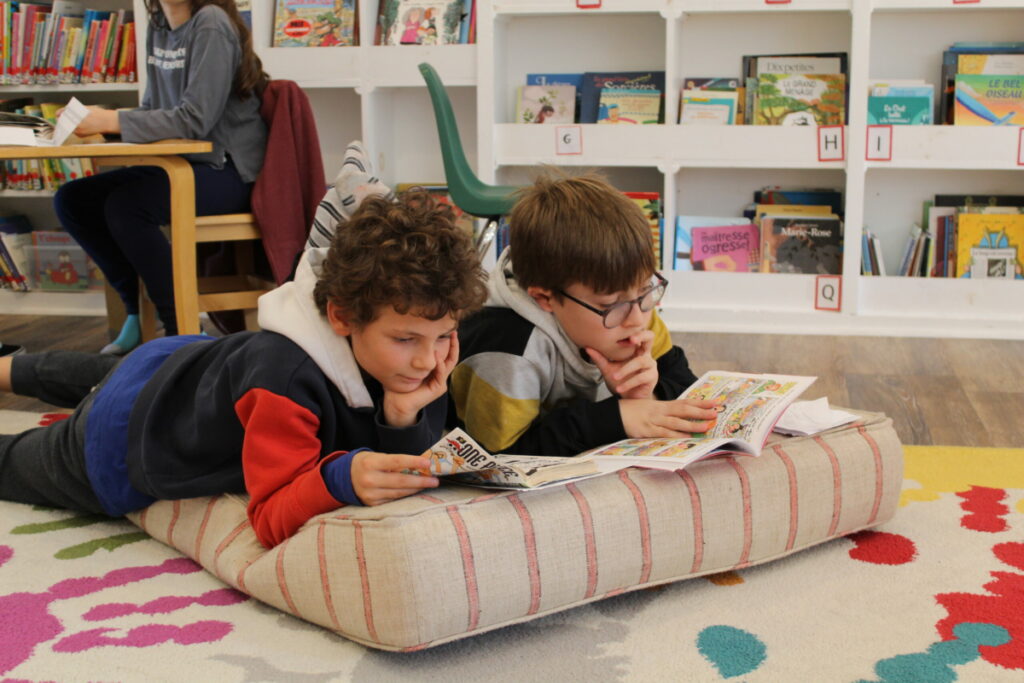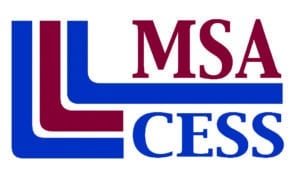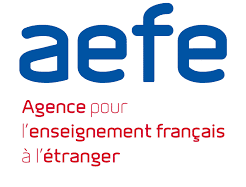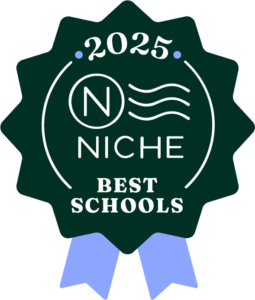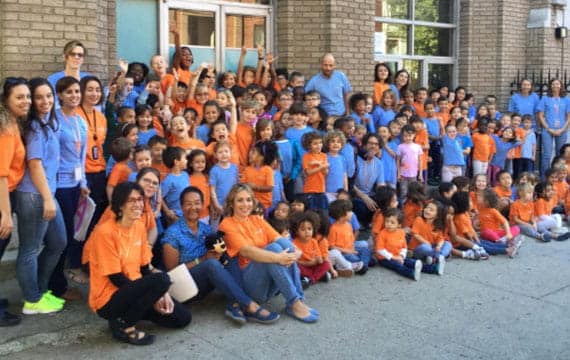Elementary School
Our Approach
In Elementary School at the French American Academy, our bilingual curriculum gives students a proven path to academic and personal success. First, it includes measurable progress in core skills like reading, writing, math, and science. Second, but equally important, it provides students with superior cognitive development and social-emotional growth through various aspects of academic life.
The Elementary curriculum develops bridges between the French Ministry of National Education program and the US Common Core to ensure students build a strong foundation for success in middle and high school and beyond.
Two Tracks Available in Elementary School
Bilingual Track
Available on the Englewood and Jersey City campuses.
This is the natural continuity of your child’s bilingual elementary education received at the French American Academy, another French-American school, or any school where French is part of the regular curriculum. Prior knowledge of French is required for admission.
International Track
Available only on the Englewood campus.
The International Track is designed to prepare students with no prior French to eventually transition into the bilingual track.
Admissions Requirements:
- Strong English language skills, which will be assessed during the admissions process.
Demonstrated ability to learn quickly, along with a willingness and interest in learning a new language.
*Students who are bilingual or demonstrate strong language aptitude are considered strong candidates for the program.
Elementary School Curriculum
To give students a strong start in math and build their confidence, our elementary curriculum uses two effective methods: Singapore Math and engaging Math Routines.
Building Deep Understanding with Singapore Math: This research-based approach helps students truly grasp the underlying principles of math, moving beyond mere memorization of rules. Students learn the “why” behind the “how” of math through a three-step process: concrete, pictorial, and abstract learning. They explore math concepts using hands-on activities, visual models, and real-world applications. This step-by-step method helps them truly understand numbers and build strong problem-solving skills that will last. Students will also learn to visualize problems and connect math to their everyday lives.
Developing Flexible Thinking with Math Routines (MitC): Alongside Singapore Math, we incorporate engaging Math Routines. Math Routines reinforce mathematical flexibility and reasoning by encouraging students to approach problems in multiple ways. Through real-life contexts, collaborative discussions, and open-ended investigations, students develop a sense of number relationships, strategic thinking, and confidence in tackling complex problems. This approach also emphasizes the use of visual models and representations, helping students make connections between different strategies and deepen their understanding of mathematical concepts.
At the elementary level, our reading and writing program is built on foundational strategies that support the development of confident, capable readers and writers.
Syllabic Method: The syllable method is a method that starts teaching reading at the beginning by presenting words that have been arranged into syllables. The syllables are arranged into the last word, stringing the words into sentences. When the reader breaks the words into syllables or smaller units it develops their syllabic analysis. For example, /mitochondria/ can be divided into /mi/-/to/-/chon/-/dri/-/a/, all identifiable syllables for a beginning reader. By breaking the word apart the student can correctly pronounce a difficult word. This helps our emergent readers to be able to string together sounds to make meaning from the words they are deciphering.
Writer’s Workshop: In Writer’s Workshop, we utilize a framework that is crafted to teach writing using repetitive steps. Writing time for each day is broken down into 3 main components: mini lesson, writing time, and sharing. It is a consistent method in the classroom that helps to introduce, practice, and improve writing skills for the students. For the mini lesson, the teacher offers direct instruction to the whole class on a specific writing skill. This may include topics such as crafting a great lead, using proper punctuation, adding details to a story, or building story suspense. The students go on to practice this skill independently and then share their work orally either in small groups or with the whole class.
There are 3 types of writing we focus on: opinion writing, expository writing, and narrative writing. The framework is the same for all writing topics, so the students learn to build good writing skills no matter the writing style they’re working on. Checklists and rubrics tailored to each writing topic help students to stay on track and identify where they are in their writing process. Teachers confer with students along the way to observe their progress and give precise feedback. Students can then create writing goals to aid them in their writing progression over the course of the school year.
Elementary school’s French and English teachers teach together to help students build bridges between the two languages. Through the MAK method developed by Marianne Verbuyt, students will take the time to study the structure of each language and compare them. Marianne Verbuyt’s method includes visual tools to make this learning process easier, more engaging, and more effective. With this well-designed and thoughtful approach for syntax, punctuation, and prosody, the students develop a stronger mastery of both French and English.
Strong speaking skills are a cornerstone of our elementary curriculum because we know that when children can express themselves confidently, it enriches their reading and writing abilities. Students have numerous exciting opportunities to hone these skills and shine as speakers.
For example, they’ll participate in:
- Bilingual Language Workshops: Designed to target and strengthen oral communication skills in both French and English.
- Bilingual Oral Presentations (starting in 1st grade): Students have frequent opportunities to present their projects bilingually throughout the year, often during classroom presentations, special events, and family-invited showcases. The 5th Grade Exit Project celebrates this development, as students choose a topic of interest and independently conduct research, write an analysis, and deliver a bilingual presentation in French and English before teachers, peers, and parents.
- Theatrical Performances: Through our yearly End-of-Year Show and other student theatrical opportunities, students develop their expressive speaking and presentation skills.
- Model United Nations (UN) Club: An opportunity to research global issues, articulate arguments, and develop public speaking skills.
- Elected Participation in Student Council: Empowering students to effectively convey their ideas and represent their peers.
- Eco-Delegates elections, workshops, and other initiatives.
The Elementary School Science curriculum blends units of study from the French and American systems. Science classes are taught bilingually with both a French and an English classroom teacher delivering instruction together. In the upper grades (4th and 5th) a trained American science teacher works with the French classroom teacher to plan and carry out science instruction.
The science curriculum aims to foster excitement and enthusiasm for discovery and concept building. The scientific method, questioning, observation, and data collection are utilized to investigate relevant, age-appropriate science concepts. Students often work in groups to foster skills of collaboration and communication. In the older grades, project-based learning is also used to delve deeper into topics. Projects might include designing and building structures such as a sustainable school, a working water wheel, and a water filtration system. The 17 United Nations Sustainable Development Goals are woven into the curriculum to prepare students to become active citizens in our interconnected world.
Our STEM curriculum focuses on developing essential skills for the future: real-world problem-solving, creativity, and collaboration.
Beginning with fun, age-appropriate tools like BeeBots, Ozobots, and Scratch Jr, students learn foundational coding concepts, directional thinking, and sequencing through both digital and unplugged activities.
As they advance, they explore more complex platforms such as Scratch, Dash, and ProBots, deepening their understanding of algorithms, loops, and debugging, all while designing games, choreographing robot movements, and solving tangible challenges.
Engineering is woven throughout the curriculum. Younger students design and build simple objects using basic materials. As they grow, they tackle more complex design challenges, working in teams to imagine, prototype, and refine technical solutions. They’re using Tinkercad to design and print objects with the 3D Printers.
Through interactive projects like treasure hunts, obstacle courses, and collaborative design tasks, our students not only learn technology but also use it to create, explore, and express themselves.
In addition, students learn how to use Chromebooks and essential Google tools safely and effectively, preparing them for digital fluency.
Learn more about our STEM classes and hands-on projects here.
Art curriculum raises interest, confidence, and makes children sensitive to beauty in their environment and beyond.
Through hands-on activities such as drawing, painting, collage, and sculpture, students learn diverse artistic techniques. These explorations are often inspired by the styles of renowned artists, from Leonardo da Vinci, Gustav Klimt, Douanier Rousseau to contemporary figures. The curriculum introduces art history through engaging stories and media, while also highlighting connections between art and other subjects like literature and history. Imagination and narrative play a central role, with projects drawing inspiration from poetry, mythology, and even architectural concepts.
As students advance, they develop their ability to analyze and reinterpret artworks, discuss them using appropriate art vocabulary, and explore various media, including shadow theaters and model making. They encounter a wide spectrum of art history, spanning ancient civilizations to modern and contemporary artists like Alexander Calder. Finally, communicating about the art process is also an essential part of the curriculum.
Music offers a progressive and engaging musical journey from the early preschool years through to upper elementary grades. Students explore a rich variety of musical genres and traditions through listening, movement, singing, and instrument play. Through the discovery of famous musical works, instruments, and sounds from around the world, children develop their musical ear, rhythmic sense, and vocal technique in age-appropriate ways.
The curriculum grows with the students, from learning basic rhythms and songs in preschool to reading music, recognizing musical intervals, and playing the ukulele in elementary grades. Emphasis is placed on creativity, collaboration, and musical expression, with measurable goals that ensure students steadily build musical confidence and competence each year.
Physical Education at the elementary level focuses on developing students’ fundamental motor skills, coordination, and physical confidence through playful and structured activities.
The program emphasizes teamwork, cooperation, and respect, while helping students build healthy habits and a positive attitude toward physical activity.
Each grade level is introduced to age-appropriate units such as locomotor skills (running, jumping, hopping), ball games, dance, circus, introductory team sports, and racket sports. Activities are designed to be inclusive, fun, and promote both physical well-being and social development.
Learning Beyond the Classroom
Field Trips
Examples of past trips:
The 2nd and 3rd graders spend three days and two nights in the Catskills or in Connecticut. Animals and habitats, sustainable development, recycling and compost, and the “Flying Squirrel” are among the highlights of the trip.
The 4th and 5th graders travel for a complete week. In other words, they are out for 5 days and 4 nights. Typically, we alternate between two trips :
- A one-week trip to Quebec, Canada, for the cultural connection
- A historical trip to Boston and Plymouth for the social study curriculum.
“This was the best time of my life” was a repeated exclamation from students upon their arrival back in NJ. Read more on field trips by visiting out field trips page.
Testing & Assessments in Elementary School
We use both the MAP Growth Assessment in English and the French National Evaluation test, which together measure key areas such as language, reading, and mathematics. These assessments help us monitor students’ progress across both academic systems and ensure alignment with international and national standards.
Assessments are an important part of learning, and we focus on helping students approach them with confidence and balance. While tests measure progress, they don’t capture traits like curiosity and empathy that are essential to growth.
By encouraging students to take risks, learn from mistakes, and view challenges as opportunities, we help them build lifelong resilience and success.

What is MAP? Measures of Academic Progress (MAP) is a computerized adaptive assessment program in English that provides FAA educators with the information they need to improve teaching and learning and make student-focused, data-driven decisions.
To who and when are MAP assessment given?
Students in grades 1 through 8 are tested two times per year in math, reading, and language usage. Students complete their 1st assessment in October to establish their starting benchmark.
In June, students complete the 2nd MAP assessment to measure how much they have progressed over the year. Educators use the growth and achievement data from MAP to develop targeted instructional strategies and to plan school improvement.
Why is it useful?
What matters for us at the French American Academy is to see students grow and reach their full academic potential. Therefore, choosing MAP testing came as a natural choice. After each assessment, teachers are provided with accurate, actionable evidence to help inform instructional strategies regardless of how far students are above or below grade level.
| Learn More |
French National Evaluation
As a private school accredited by the French Government, we are following the recommendations from the Ministry of National Education in terms of standardized tests. Therefore, in September, 1st and 2nd graders are taking a test in Math, Reading and Writing like any other 1st or 2nd graders who live in France.
DELF Exam
What is DELF? The DELF exam assesses four language skills: listening comprehension, reading comprehension, speaking skills, and writing skills.
How is it taken?
3rd, 5th, and 8th-grade students at the French American Academy take the DELF exam (Diplôme d’études en langue française). Official diplomas are awarded by the French Ministry of Education for proficiency in French as a Foreign Language.
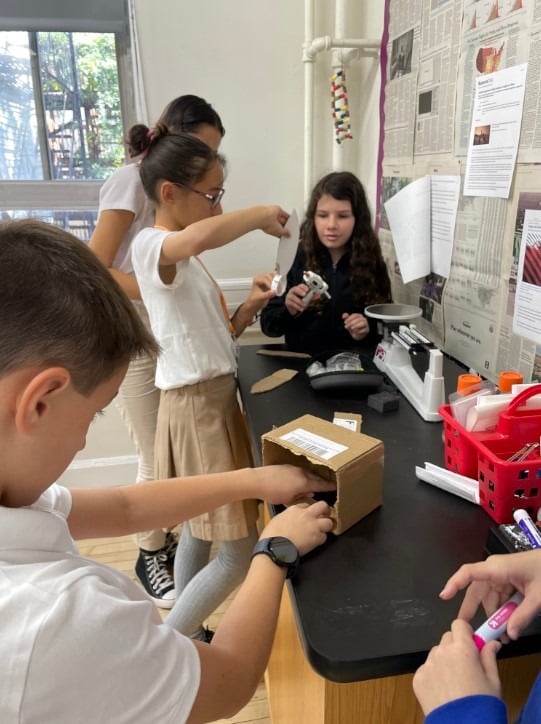
Enrichment Program
Discover, Play, and Learn
Our after-school enrichment program offers elementary students a variety of activities to discover new interests and have fun. From gymnastics and chess to piano and lego robotics, we aim to nurture a love for learning outside the classroom.
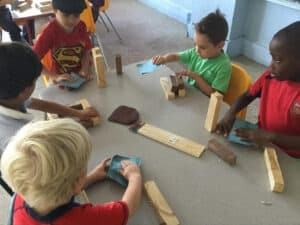
Meet Giti - Thriving in Our Bilingual Program
Giti, an elementary student, opens up about how our bilingual curriculum helps her think in new ways, connect with different cultures, and grow more confident both inside and outside the classroom, even without speaking French at home.
Discover What's New in Elementary School
Smart Screen Use: How to Promote Healthy and Productive Technology Habits
Supporting Every Learner: How The French American Academy Meets Diverse Student Needs
Happy Holidays to our wonderful community! 🎄✨
Flashback on our first graders, they filled the classroom with joy as they presented their Family Tradition Posters.
It was a beautiful celebration of what makes each of our students unique, and a great way to practice those speaking and listening skills! 🖼️🗣️
We are so grateful for our supportive community.
Thank you for making this year so special!
We hope your holiday is filled with the same warmth and pride we felt in the classroom through this presentation! ❄️❤️
#SchoolCommunity #FirstGradeMagic #FamilyTraditions #HappyHolidays #LearningTogether

Happy Holidays to our wonderful community! 🎄✨
Flashback on our first graders, they filled the classroom with joy as they presented their Family Tradition Posters.
It was a beautiful celebration of what makes each of our students unique, and a great way to practice those speaking and listening skills! 🖼️🗣️
We are so grateful for our supportive community.
Thank you for making this year so special!
We hope your holiday is filled with the same warmth and pride we felt in the classroom through this presentation! ❄️❤️
#SchoolCommunity #FirstGradeMagic #FamilyTraditions #HappyHolidays #LearningTogether
…
❄️🎶 Winter Show at our Englewood Campus 🎶❄️
This morning, our Englewood community gathered at St. Cecilia’s Church for a beautiful Winter Show filled with music, movement, and shared moments across all grades.
From the whole-school opening dance to joyful songs performed by our youngest students and uplifting classics sung by our elementary classes, every performance reflected creativity, confidence, and togetherness.
The show ended with a powerful whole-school rendition of Seasons of Love, a perfect way to close a meaningful morning.
A huge thank you to our students, teachers, and families for making this moment so special. We are incredibly proud of our Englewood campus 🤍
#FrenchAmericanAcademy #FAAEnglewood #WinterShow #SchoolCommunity #MusicAndMovement #BilingualSchool

❄️🎶 Winter Show at our Englewood Campus 🎶❄️
This morning, our Englewood community gathered at St. Cecilia’s Church for a beautiful Winter Show filled with music, movement, and shared moments across all grades.
From the whole-school opening dance to joyful songs performed by our youngest students and uplifting classics sung by our elementary classes, every performance reflected creativity, confidence, and togetherness.
The show ended with a powerful whole-school rendition of Seasons of Love, a perfect way to close a meaningful morning.
A huge thank you to our students, teachers, and families for making this moment so special. We are incredibly proud of our Englewood campus 🤍
#FrenchAmericanAcademy #FAAEnglewood #WinterShow #SchoolCommunity #MusicAndMovement #BilingualSchool
…
❄️🌿 Winter Show at our Jersey City Downtown Campus 🌿❄️
Yesterday, our Jersey City Downtown campus came together for two Winter Shows of The Nature Show.
In the morning, our PreK and Kindergarten students opened the day with joyful songs and movements inspired by nature.
Later on, our elementary students from 1st to 5th grade took the stage, sharing performances in French, English, and both languages.
Across both shows, students explored themes of nature, the environment, and collective responsibility, ending with beautiful shared moments that truly reflected our school spirit.
A big thank you to our teachers, staff, and families for making this day so meaningful.
We are incredibly proud of our students 🌍💙
#FrenchAmericanAcademy #FAAJerseyCity #WinterShow #TheNatureShow #BilingualSchool #SchoolCommunity

❄️🌿 Winter Show at our Jersey City Downtown Campus 🌿❄️
Yesterday, our Jersey City Downtown campus came together for two Winter Shows of The Nature Show.
In the morning, our PreK and Kindergarten students opened the day with joyful songs and movements inspired by nature.
Later on, our elementary students from 1st to 5th grade took the stage, sharing performances in French, English, and both languages.
Across both shows, students explored themes of nature, the environment, and collective responsibility, ending with beautiful shared moments that truly reflected our school spirit.
A big thank you to our teachers, staff, and families for making this day so meaningful.
We are incredibly proud of our students 🌍💙
#FrenchAmericanAcademy #FAAJerseyCity #WinterShow #TheNatureShow #BilingualSchool #SchoolCommunity
…
✨ A Day in the Life: Future Heights Campus Stars! 🌟
We rolled out the red carpet for our "Freshman for a Day" participants on Thursday, December 11th, giving Grade 8 students a true taste of the school life at our Heights campus!
From 8:45 AM to 3:00 PM, the students weren`t just observing, they were doing!
They jumped into our dynamic, immersive academic environment:
📐 Design Thinking in the Makerspace: Getting hands-on with innovative design activities and sketching up ideas, showcasing the creativity fueled by our curriculum.
⚽ European Handball (Delivered in English & French!): A high-energy Physical Education class, demonstrating our commitment to bilingual instruction even in sports!
🎭 Integrated Arts/Theatre in French: Exploring creative expression and mastering the language through performance and visual arts.
🔬 Integrated Math and Science: A deep dive into complex concepts, proving that our rigorous academics are also engaging and exciting.
📚 Individuals and Societies/Literature: Engaged discussions in both Anglophone and Francophone tracks, highlighting the strength of our bilingual, tailored education.
It was an action-packed day of intellectual exploration, collaborative fun, and getting to know the amazing teachers and students who make our school a unique place to learn and thrive.
We believe in providing a truly world-class, bilingual education that prepares students for the future.
Ready to see our excellent academics and vibrant community firsthand? Schedule a school tour to see the school for yourself!
#FreshmanForADay #FAAHeights #BilingualEducation #PrivateSchoolLife #FutureFreshman #JerseyCitySchools #HeightsCampus #AcademicExcellence #InquiryBasedLearning #DesignThinking #AdmissionsOpen #SchoolTour #InternationalSchool

✨ A Day in the Life: Future Heights Campus Stars! 🌟
We rolled out the red carpet for our "Freshman for a Day" participants on Thursday, December 11th, giving Grade 8 students a true taste of the school life at our Heights campus!
From 8:45 AM to 3:00 PM, the students weren`t just observing, they were doing!
They jumped into our dynamic, immersive academic environment:
📐 Design Thinking in the Makerspace: Getting hands-on with innovative design activities and sketching up ideas, showcasing the creativity fueled by our curriculum.
⚽ European Handball (Delivered in English & French!): A high-energy Physical Education class, demonstrating our commitment to bilingual instruction even in sports!
🎭 Integrated Arts/Theatre in French: Exploring creative expression and mastering the language through performance and visual arts.
🔬 Integrated Math and Science: A deep dive into complex concepts, proving that our rigorous academics are also engaging and exciting.
📚 Individuals and Societies/Literature: Engaged discussions in both Anglophone and Francophone tracks, highlighting the strength of our bilingual, tailored education.
It was an action-packed day of intellectual exploration, collaborative fun, and getting to know the amazing teachers and students who make our school a unique place to learn and thrive.
We believe in providing a truly world-class, bilingual education that prepares students for the future.
Ready to see our excellent academics and vibrant community firsthand? Schedule a school tour to see the school for yourself!
#FreshmanForADay #FAAHeights #BilingualEducation #PrivateSchoolLife #FutureFreshman #JerseyCitySchools #HeightsCampus #AcademicExcellence #InquiryBasedLearning #DesignThinking #AdmissionsOpen #SchoolTour #InternationalSchool
…
Elementary School FAQs
At the French American Academy, French proficiency requirements vary by campus and grade level.
Englewood Campus: No French is required for admission in elementary school. Students in 1st grade and above may choose between two tracks:
The Bilingual Track, which requires some prior knowledge of French.
The International Track, designed for students with no French experience.
Jersey City Downtown Campus: Students entering Grade 1 and above are expected to have some prior knowledge of French.
No matter the track or campus, we understand that language learning can be challenging. Our teachers provide extra support, and our nurturing environment helps every child grow in confidence and reach their full potential.
In Elementary school at the French American Academy, all of our French teachers are from countries where French is the official language and speak French as their native language and all our English teachers are native English speakers.


